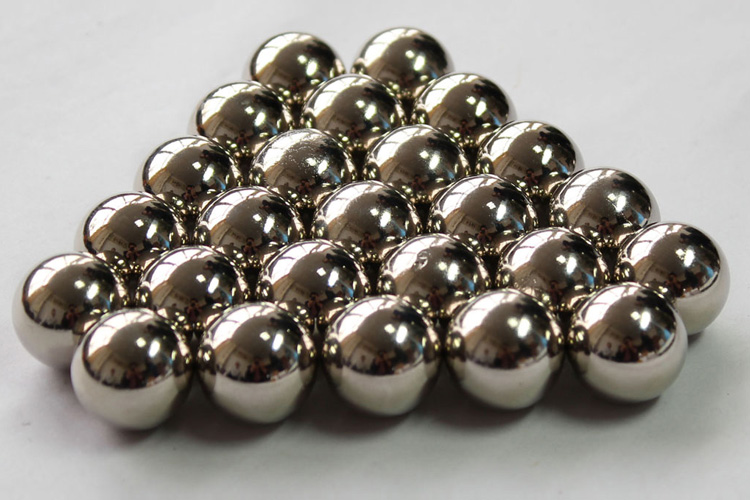Nickel is silvery-white, hard, malleable, and ductile metal. It is of the iron group and it takes on a high polish. It is a fairly good conductor of heat and electricity. In its familiar compounds nickel is bivalent, although it assumes other valences. It also forms a number of complex compounds.
Nickel is a metal, commonly used to make coins, magnets, jewelry, stainless steel, electronics, and components of industrial machines. Most people are familiar with the attractive mirror-finish that can be achieved by nickel plating. However, despite the beautiful appearance, nickel exposure, especially in industrial and occupational settings, can present significant health hazards.
The major use of nickel is in the preparation of alloys. Nickel alloys are characterized by strength, ductility, and resistance to corrosion and heat. About 65 % of the nickel consumed in the Western World is used to make stainless steel, whose composition can vary but is typically iron with around 18% chromium and 8% nickel. 12 % of all the nickel consumed goes into super alloys. The remaining 23% of consumption is divided between alloy steels, rechargeable batteries, catalysts and other chemicals, coinage, foundry products, and plating.
Nickel is easy to work and can be drawn into wire. It resist corrosion even at high temperatures and for this reason it is used in gas turbines and rocket engines. Monel is an alloy of nickel and copper which is not only hard but can resist corrosion by sea water, so that it is ideal for propeller shaft in boats and desalination plants.
Exposure to metal dust, unfortunately, is common with some occupations like mining, factory work, and welding. Welding can be especially worrisome because it produces vapors that, when inhaled, send the alloy directly into the lungs in a “super absorption” status where it is released to the blood and distributed to the bones and brain. Researchers have repeatedly examined the consequence of inhaling metal vapors and the results are grim. Effects on memory and concentration have been cited.
Nickel Dust is Combustible and is an Explosion Hazard:
When most people think of controlling dust in the workplace, they think of taking steps to avoid inhaling dusts to prevent health problems. However, the accumulation of combustible dusts in the workplace can lead to far greater consequences. As seen in recent years, neglect of housekeeping and improper handling of combustible dusts can lead to property damage, injuries and loss of life.
During fabricating operations, Copper fines may be generated by such activities as grinding, polishing, sawing, cutting, sanding or scratch brushing and at least some of them will be fine enough to be potentially explosive. The term “dust” or “powder” is frequently used to describe such particles.
The National Fire Protection Association (NFPA) defines a combustible dust as “a combustible particulate solid that presents a fire or deflagration hazard when suspended in air or some other oxidizing medium over a range of concentrations, regardless of particle size or shape.” In general, combustible particulates having an effective diameter of 420 μm or smaller, as determined by passing through a U.S. No. 40 Standard Sieve, are generally considered to be combustible dusts. However, agglomerates of combustible materials that have lengths that are large compared to their diameter (and will not usually pass through a 420 μm sieve) can still pose a deflagration hazard. Therefore, any particle that has a surface area to volume ratio greater than that of a 420 μm diameter sphere should also be considered a combustible dust. The vast majority of natural and synthetic organic materials, as well as some metals, can form combustible dust. The NFPA’s Industrial Fire Hazards Handbook states, “any industrial process that reduces a combustible material and some normally non-combustible materials to a finely divided state presents a potential for a serious fire or explosion.”
Suggested Industrial Vacuums for Recovery of Toxic & Combustible Dust
PrestiVac HEPAPlus* Vacuums are specifically designed to safely vacuum toxic dusts. Equipped with a Certified Absolute HEPAPlus*filter with an efficiency of 99.995% on 0.2 micron so there is no risk of exposure or contamination for the operator or the environment. These vacuums are tested for absolute filtration. Testing Method: IEST RP-CC034.3. H14. MIL-STD 282 / A.S.T.M. - D2986-91. MPPS method EN 1822.
PrestiVac Explosion Proof/Dust Ignition Protected Vacuums are designed to safely vacuum explosive, flammable, combustible conductive* dusts. Our Explosion Proof/Dust Ignition Protected Vacuums are completely grounded and static dissipating because they are built entirely with non-sparking metals and do not have any painted components so there is no risk of fire or explosion from a spark or static build up. All the electrical components, including the motor and starter are totally enclosed so there is no source of ignition. Our explosion proof vacuum cleaners comply with NFPA 484 guidelines and are an effective tool for good housekeeping practise as per OSHA.
- Dustless Sanding Vacuums
- Explosion Proof Division 1 Vacuums
- HEPA Vacuums
- Immersion Separator
- Immersion Separator Dustless Sanding Vacuums
Which Industries are at Risk with Nickel Dust?













